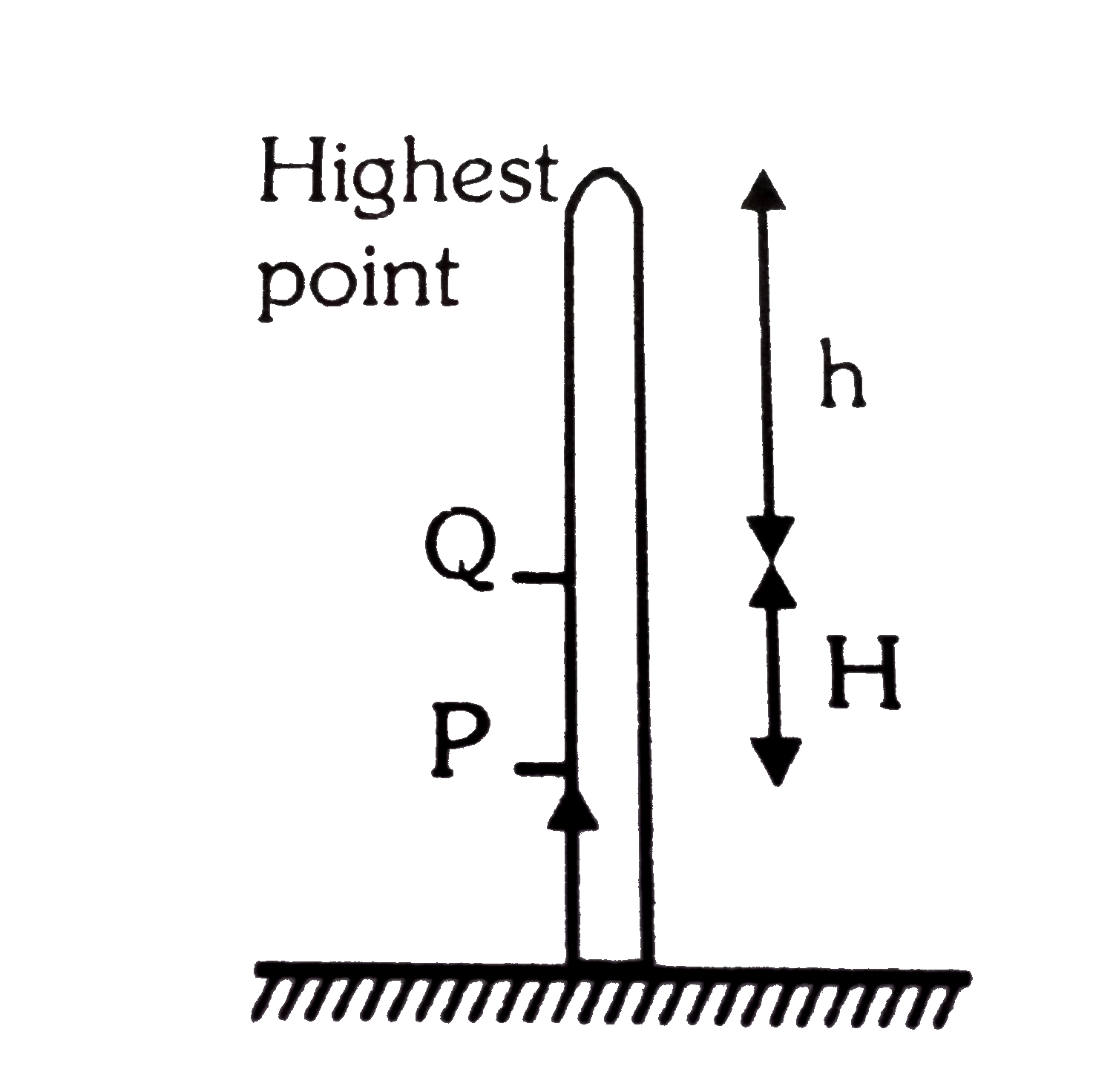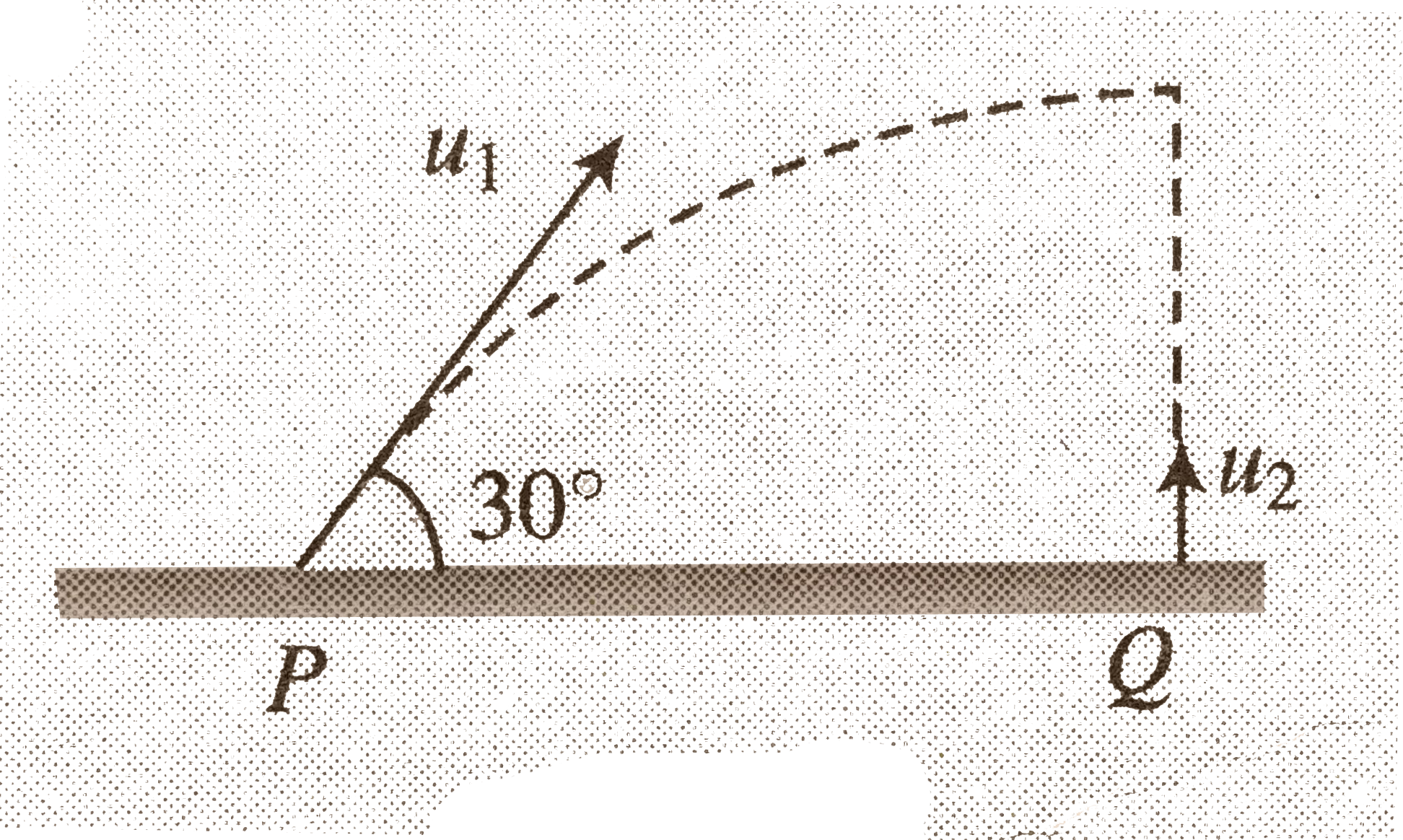A particle is thrown vertically upwards from the surface of the earth. Let TP be the time taken by the particle to travel from a point P above the earth to its highest point and back to the point P. Similarly, let TQ be the time taken by the particle to travel from another point Q above the earth to its highest point and back to the same in terms of TP,TQ and H, is :-Solution in Gujrati
Time taken from point P to point P TP=2√2(h+H)g
Time taken from point Q to point Q TQ=2√2hg
⇒T2p=8(h+H)g&T2Q=8hg⇒T2P=T2Q+8Hg
⇒g=8HT2P−T2Q

Topper's Solved these Questions
- MOTION IN A PALNEBOOK - ALLEN CHAPTER - MOTION IN A PALNEEXERCISE - EXERCISE-1
99 Videos
- MOTION IN A PALNEBOOK - ALLEN CHAPTER - MOTION IN A PALNEEXERCISE - EXERCISE-2
170 Videos
- MOTION IN A PALNEBOOK - ALLEN CHAPTER - MOTION IN A PALNEEXERCISE - Integer Type Question
3 Videos
- KINEMATICS-2DBOOK - ALLEN CHAPTER - KINEMATICS-2DEXERCISE - Exercise (O-2)
47 Videos
- NEWTON'S LAWS OF MOTION & FRICTIONBOOK - ALLEN CHAPTER - NEWTON'S LAWS OF MOTION & FRICTIONEXERCISE - EXERCISE (JA)
4 Videos
Similar Questions
The distance x of a particle moving in one dimensions, under the action of a constant force is related to time t by the equation, t=√x+3, where x is in metres and t in seconds. Find the displacement of the particle when its velocity is zero.
View SolutionThe velocity of a particle moving with constant acceleration at an instant t0 is 10m/s After 5 seconds of that instant the velocity of the particle is 20m/s. The velocity at 3 second before t0 is:-
View SolutionA stone is dropped from the top of a tower of height h. Aftre 1s another stone is droppped from the balcony 20m below the top. Both reach the bottom simultaneously. What is the value of h ? Take g=10ms−2.
View SolutionA particle is moving in xy-plane .At certain instant the components of its velocity and acceleration are as follows ux=3m/s,uy=4m/s,ax=2m/s2anday=1m/s2. The rate of change of speed at this moment is
View SolutionA piece of wire is bent in the shape of a parabola y=kx2 (y-axis vertical) with a bead of mass m on it. The bead can slide on the wire without friction. It stays at the lowest point of the parabola when the wire is at rest. The wire is now accelerated parallel to the x-axis with a constant acceleration a. The distance of the new equilibrium position of the bead, where the bead can stay at rest with respect to the wire, from the y-axis is:
View SolutionFrom a tower of height H, a particle is thrown vertically upwards with a speed u . The time taken by the particle , to hit the ground , is n times that taken by it to reach the highest point of its path. The relative between H,uandn is :
View SolutionA particle P is projected with velocity u1 at an angle of 30∘ with the horizontal. Another particle Q is thrown vertically upwards with velocity u2 from a point vertically below the highest point of path of P. Determine the necessary condition for the two particles to collide at the highest point.
 .
.
View SolutionAn onject is thrown vertically upward with some speed. It crosses 2 points p,q whith are separated by (h) metre. If (t) is the time between (p) and highest point and coming back and t_(q) is the time between q and highest point and coming back, relate acceleration due to gravity t_(p),t_(q) and h .
View SolutionA particle is thrown vertically upwards from the surface of the earth. Let T_(P) be the time taken by the particle to travel from a point P above the earth to its highest point and back to the point P. Similarly, let T_(Q) be the time taken by the particle to travel from another point Q above the earth to its highest point and back to the same in terms of T_(P), T_(Q) and H, is :-
View SolutionA particle is projected vertically from the ground, takes time t_(1) upto point A, t_(2) from point A to B and time t_(3) from point B to highest point and back to the ground. Find the height of the middle point of A and B from the ground.
View SolutionFrom a tower of height H, a particle is thrown vertically upwards with a speed u. The time taken by the particle, to hit the ground, is n times that taken by it to reach the highest point of its path. The relation between H, u and n is
View SolutionFrom a tower of height H, a particle is thrown vertically upwards with a speed u. The time taken by the particle, to hit the ground, is n times that taken by it to reach the highest point of its path. The relation between H, u and n is :
View SolutionFrom a tower of height H a particle is thrown vertically upwards with a speed U. The time taken by the particle, to hit the ground, is n times that taken by it to reach the highest point of its path.
View Solutionपृथ्वी की सतह से एक कण को ऊर्ध्वाधर ऊपर फेंका जाता है। मान लो कि यह क पृथ्वी से ऊपर एक बिंदु P से अपने उच्चतम बिंदु तक जाकर वापस बिंदु P तक आने में TP समय लेता है। इसी प्रकार इस कण को पृथ्वी से ऊपर एक अन्य बिंदु Q से अपने उच्चतम बिंदु तक जा कर वापस बिंदु Q तक आने में TQ समय लगता है P ओर Q के बीच की दूरी H हो, तो TP,TQ और H के पदों में गुरुत्वीय त्वरण के लिए व्यंजक ज्ञात कीजिए।
View SolutionFrom a tower of height H, a particle is thrown vertically upwards with a speed u. The time taken by the particle, to hit the ground, is n times that taken by it to reach the highest point of its path. The relation between H, u and n is
View SolutionFrom a tower of height H ,a particle is thrown vertically up with a speed V. The time taken by the particle to hit the ground 3 times that taken by it to reach highest point of is path. Then find H.
View Solution
